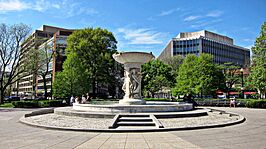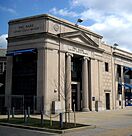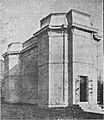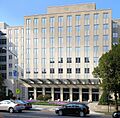Dupont Circle facts for kids
Quick facts for kids
Dupont Circle
|
|
|---|---|
|
Neighborhood of Washington, D.C.
|
|
|
Clockwise from the top: Dupont Circle Fountain; Connecticut Avenue; St. Matthew's Cathedral; historic Riggs Ntl. Bank; Patterson Mansion.
|
|
| Country | United States |
| District | Washington, D.C. |
| Quadrant | Northwest |
| Ward | 2 |
Dupont Circle is a famous historic park and neighborhood in Washington, D.C.. It is located in the Northwest part of the city. The neighborhood is known for its many embassies and think tanks. These are organizations that do research and offer advice on important topics.
The traffic circle itself is where several major streets meet, including Massachusetts Avenue and Connecticut Avenue. It is named after Rear Admiral Samuel Francis Du Pont, a hero from the Civil War. In the middle of the circle, you'll find the beautiful Dupont Circle Fountain.
Contents
History of Dupont Circle
The area where Dupont Circle is located was part of the original plan for Washington, D.C., designed by Pierre Charles L'Enfant. However, it stayed mostly undeveloped until after the American Civil War. In the 1870s, the area began to change into a popular residential neighborhood.
From Pacific Circle to Dupont Circle
In 1871, the U.S. Army Corps of Engineers started building the traffic circle. It was first called Pacific Circle. On February 25, 1882, the Congress officially renamed it "Dupont Circle." This was to honor Rear Admiral Samuel Francis Du Pont for his service during the Civil War.
A statue of Admiral Du Pont was placed in the circle in 1884. However, some of his family members thought the statue was too small. So, in 1917, they moved the statue to Wilmington, Delaware. They then asked famous designers Henry Bacon and Daniel Chester French to create a new memorial. These two also designed the Lincoln Memorial.
In 1920, the current white marble Dupont Circle Fountain was put in place. It has carvings of three figures that represent the sea, the stars, and the wind.
Growth and Change in the Neighborhood
In the late 1800s, many large mansions and townhouses were built in Dupont Circle. Wealthy families and important people moved into the area. For example, the British built a new embassy on Connecticut Avenue in 1872.
One famous home, the Patterson House at 15 Dupont Circle, was even a temporary home for President Calvin Coolidge in 1927. This was while the White House was being repaired. Famous pilot Charles Lindbergh also stayed there after his historic flight across the Atlantic Ocean.
As more people moved to the city, traffic in Dupont Circle became very busy. To help with this, tunnels and an underground streetcar station were built in 1949. These tunnels allowed cars and streetcars to pass under the circle more easily. When streetcar service ended in 1962, the entrances to the underground station were closed. Today, this space has been turned into the Dupont Underground, an art and performance area.
After World War II, the neighborhood faced some challenges. But in the 1970s, it started to become popular again. Many people looking for a unique lifestyle moved there. The area became known for its lively and diverse community. For example, a bookstore called Lambda Rising opened in 1974. Today, Dupont Circle is a trendy spot with many coffee shops, restaurants, and stores. Since 1997, a weekly farmers market has been held there every Sunday.
Architecture in Dupont Circle
The homes in Dupont Circle are mostly rowhouses built before 1900. They often feature styles like Queen Anne and Richardsonian Romanesque. You can also find grand mansions and large freestanding houses along the wide avenues. These larger homes were built in popular styles from the late 1800s and early 1900s.
The Patterson Mansion
One example of a grand home is the marble and limestone Patterson Mansion at 15 Dupont Circle. It was built in 1901 by architect Stanford White. This mansion is the only one left of the many that once surrounded the circle. It was a center for social life in Washington, D.C. As mentioned, President Calvin Coolidge and his wife stayed here in 1927. Charles Lindbergh was also a guest after his famous flight.
Strivers' Section
Part of Dupont Circle includes a small residential area called the Strivers' Section. This area is west of 16th Street. In the late 1800s and early 1900s, it was home to many successful African Americans. These were often community leaders. The area includes houses once owned by Frederick Douglass. It got its name from a writer who called it "the Striver's section," meaning a place where people worked hard to succeed. Today, it is a historic district with many original Edwardian-era homes.
Landmarks and Institutions
The Traffic Circle Park
The park in the center of Dupont Circle is a popular gathering spot. It is managed by the National Park Service. The Dupont Circle Fountain offers places to sit. You can often see people playing chess on the permanent stone chessboards in the park. The park has also been used for community events and rallies.
In 2014, a special "kinetic park" was built on the south side of the circle. It uses special PaveGen pavers that create electricity when people walk on them. This energy helps power lights under the benches in the park.
Embassies in the Neighborhood
Dupont Circle is famous for its many embassies. These are like small pieces of other countries located in Washington, D.C. Many embassies are in beautiful historic buildings. For example, the Thomas T. Gaff House is the home of the Colombian ambassador. The Walsh-McLean House is now the Indonesian embassy. Other countries with embassies in Dupont Circle include Uzbekistan, Peru, and Iraq.
Other Important Places
Many other landmarks in Dupont Circle are listed on the National Register of Historic Places. These include:
- The Christian Heurich Mansion, also known as Brewmaster's Castle.
- The Phillips Collection, which was the first museum of modern art in the United States. It is famous for Renoir's painting Luncheon of the Boating Party.
- The Cosmos Club, located in the Richard H. Townsend House.
- The historic Anderson House, which is open for tours.
- The Mansion on O Street, a unique hotel and museum with over 100 rooms and 32 secret doors.
Research and Education Centers
Dupont Circle is home to many important think tanks and research groups. These organizations study global issues and help shape policy. Some well-known ones include the American Enterprise Institute, the Brookings Institution, and the Carnegie Endowment for International Peace. The Paul H. Nitze School of Advanced International Studies (SAIS) of Johns Hopkins University is also nearby.
Transportation
Dupont Circle is easy to reach by public transportation. The Dupont Circle station is on the Red Line of the Washington Metro. There are two entrances to the station. The northern entrance has a quote carved into it from a poem by Walt Whitman.
Annual Neighborhood Events
Capital Pride Parade
Capital Pride is a large annual festival held every June in Washington, D.C. It celebrates the community and its allies. The Capital Pride parade travels through the streets of the Dupont Circle neighborhood. It is one of the largest events of its kind in the United States.
High Heel Race
The Dupont Circle High Heel Race is a fun and unique event held every year. It takes place on the Tuesday before Halloween (October 31). Dozens of drag queens race down 17th Street NW in high heels. Thousands of spectators come to watch this exciting and colorful event.
Images for kids
-
A Maypole in Dupont Circle
-
The headquarters of the Brookings Institution
See also
 In Spanish: Dupont Circle para niños
In Spanish: Dupont Circle para niños

















